Home >
Matabeleland North >
Some History on Chief Sileya (Shona: Chireya) and the Vashangwe community in the Sebungwe district
Some History on Chief Sileya (Shona: Chireya) and the Vashangwe community in the Sebungwe district
This article is composed from a number of articles in NADA (The Southern Rhodesia Native Affairs Department Annual) that were copied for me by Justin Seymour-Smith whose father at one time had a hunting concession in the Sebungwe District and was interested in the history and ethnography[1] of the local people. Much of the detail for this article came from eight pages of typed notes on the Chiefs, Headmen and communities that lacked a title, and indeed, the name of the author – where I have added information from other NADA sources this is given in the notes.
The Sebungwe District in which the authors of the articles were stationed had as its administrative centre Old Gokwe until the tsetse-fly belt shifted about 1920 and the centre moved east to present-day Gokwe. The District itself covered a huge area as seen in the map below.
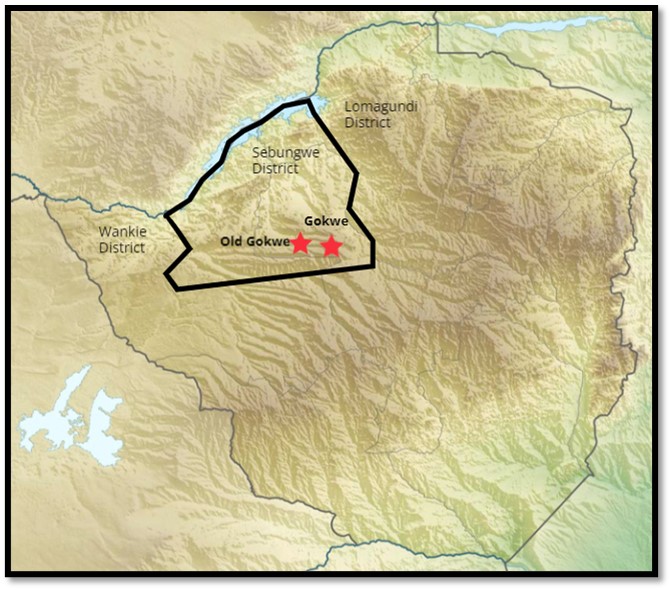
The Sebungwe District with the Zambesi river as the northern boundary
One of the Native Commissioners, Herbert Hemans, wrote a book on his experiences in the Sebungwe District entitled The Log of a Native Commissioner that has been summarised on this website.[2]
The Vashangwe
Chief Sileya’s tribe is Shangwe and originally VaRozvi. Some say they originate from the Masvingo area, a place called Nauswa (‘without trees’) where their Mutupo / Chidao[3] was originally Moyo but was changed to Shava Mpofu[4] and their mudzimu was Nyamuswa.
Parkinson’s informants state they originally lived at Kunauhwa Hill which is stated variously to be in the Buhera or Masvingo area. As a result of a chieftainship dispute they say that fighting broke out and that Chief Sileya, son of Nyahuni, was defeated and headed west.[5]
They found themselves at Shangwe whose chief was Nyamusasa and he had a special cow which was white with a black spot on its side. Nyamusasa and his wife would enter the cow’s stomach through the black spot. The cow’s urine was saved as it contained salt that was extracted by boiling and used for cooking. Sileya sent meat to Nyamusasa who had the meat cooked, added salt and returned it to Sileya who found the meat extremely tasty and asked the cooks what they had added and after some hesitation they told him it was salt. Sileya wanted more, so he sent his men to kill the cow which they did, Nyamusasa died of grief, the cow’s body swelled and burst and formed a pan into which Nyamusasa and his kraal sank without trace.
Sileya was amazed and after tasting the water of the pan found it was salty. So much did they like the salt that he and his people settled in the area. They scraped up the earth from the salt pan and separated out the salt (kupara) and the pan itself was called Bari. Then the chief constructed a platform ten feet high for Chivundika the drum. After the death of Nyamusasa the drum moved about the kraals and when it had passed-by most of Nyamusasa’s people died, although a few survived. Their mutupo is Shoko, chidao Deva.
Later Chivundika moved north alone and tried to swim across the Zambesi river. The BaTonga on the north bank were afraid and gathered weapons and attacked the drum with spears. Wounded many times Chivundika turned back and after resting a short while at Nyamafuro went back to Kunauhwa Hill. It was said that until recently its track could be seen as where it passed the grass was shorter.
Chief Chimera took the title Sileya (Chireya) meaning ‘one who twisted and turned to avoid pursuit’ as they had done in moving from Kunauhwa Hill. They also changed their mutupo to Shava Mpofu which was the meat most liked by Chimera. As their chidao they took Nyahuni, the father of Chimera (now Chief Sileya) and called themselves the Vashangwe.
The Vashangwe never suffered from amaNdebele raiding as they paid tribute to Lobengula in salt, just as Chief Nemangwe paid his tribute in Nyoka tobacco.[6]
Marr’s notes state that the Shangwe originally came from Guruuswa. That Chief Chimera was a VaRozvi and moved from the area around Bulawayo to the Sebungwe District before any whites had come to the country and even before the amaNdebele had come up from the south in the 1830’s.[7] They chased Nyamusasa out of Sebungwe and that is why they are called Vashangwe (shangwa ‘ shield’ and ku-shangura ‘to hit or slap’)
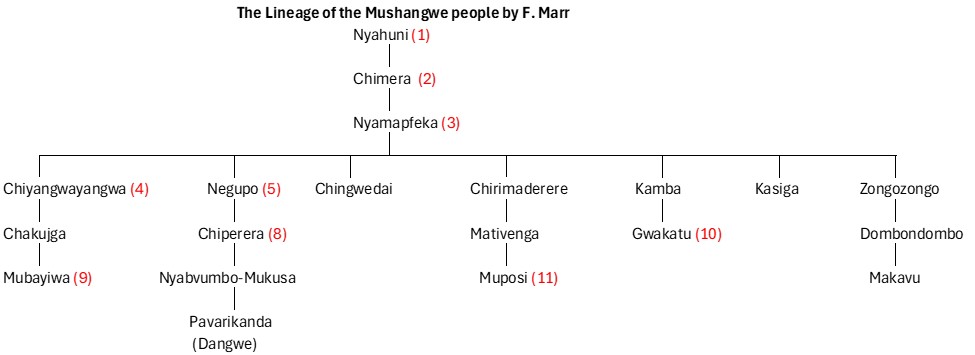
M.E. Hayes confirms the above succession chart.
Chief Sileya (Chireya)
The chief told Marr that he had been appointed after the Native Commissioner’s camp had moved from Old Gokwe to the new site at present-day Gokwe.[8] He states Kamba[9] named him as the new chief and that his selection took place when the people were gathered together to pay tax and the appointment was fully discussed by them. The men then carried him to the dzimbabwe[10] and two sheep were killed by dunzvi Kabarapati and all the men ate, but not the chief. After this the vakatora Ngundu (head-dress) was put on Chief Sileya.
Then a messenger was sent to the great mhondoro Nyadati (Newawa) of Nemakonde near Chinhoyi with a small quantity of tobacco snuff. The mhondoro accepted this and sent back a small quantity of other snuff and this showed he approved of the selection of the new chief. If he had not approved, he would have refused the snuff and not sent any back and the new chief would soon have died. Thus the mhondoro has the final selection of any new chief, not the people.
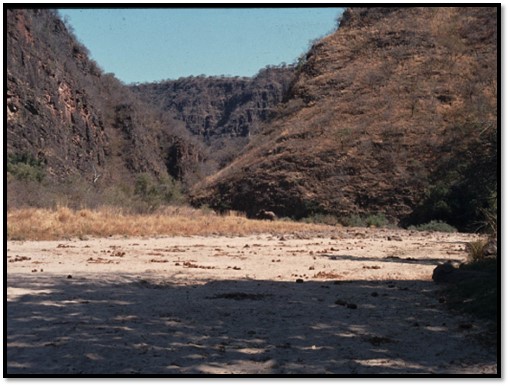
Photo Justin Seymour-Smith: Entrance to Sengwa Gorge, north-east Chizarira
Mhondoro’s and svikiro’s
Chief Sileya said they had their own mhondoro Nyagocha who must approve also, but Nyadati of Nemakonde is a very big mhondoro and has a svikiro through whom he speaks, and when Chief Chimera moved to Sebungwe Nyagocha was not yet a mhondoro. Chief Sileya said the svikiro is a male, but it is not a hereditary office. The mhondoro chooses his svikiro by possessing him. The man chosen will wander around not knowing what he is doing and in due course becomes possessed and the mhondoro will speak through him.
The chief said that Nyagocha had a svikiro called Marariromba who had been his svikiro for many years now. His selection was different. He came from the Mfungo community and whilst there he became ill and started wandering around and singing and seemed to be possessed by some spirit. Finally all the men sat down near him and honoured him by clapping hands (hombera) and then the mhondoro Nyagocha spoke through him. Chief Sileya initially refused to believe and as a test pulled out one pound (£1) and put it on the ground saying, “if this is true let it rain today.” Rain fell almost immediately and then the chief was satisfied and Marariromba has been the svikiro ever since.
The chief said when he needs to consult the mhondoro Nyagocha he usually sends his dunzvi Kabarapati to Marariromba with some white beads or money and honours him. Then the svikiro becomes possessed by Nyagocha. The chief added that the mhondoro really rules the country. If for example, the chief ruled badly and Nyagocha became angry, all the people would go to him and he would speak and the chief would be forced to act as the mhondoro required. The chief cannot refuse the commands of the mhondoro. If he did the whole country would dry up and the rains would fail. He went on to say the dead have more power than the living. Generally, the common people would come to the chief first before consulting the mhondoro, otherwise he would not speak to them. However the sons of a chief may consult the mhondoro directly because of the size of the Sebungwe country and the long distances that have to be walked.
In 1974 when Hayes wrote his notes the spirit (Ngozi in Shangwe[11]) of the founding ancestor Nyahuni had come out in the medium Kabanamana Rabson at Taka kraal. When information on rain is required the people brew beer and it is offered to the spirit medium who will speak in the name of the spirit.
The manner in which an Ngozi will come out
Chief Kanyoka Sileya explained to Hayes as follows. A man might be sick and he consults a diviner who ‘throws the bones’ and says an Ngozi spirit is responsible. This is the spirit of a deceased person but it will not be known who that person is. The people are called together and beer is drunk and they dance to mbira music with the women wearing ‘magavu’ on their legs which make a rattling sound. The sick person is taken into a hut and seated on a mat. He/she is made to inhale the smoke from a burning root of a tree called mbanda with their head covered with a piece of cloth. The spirit will then come out and identify itself.
A second mbira ceremony is then held at which the medium is made to drink the blood of a goat that is the same sex as the medium. The ceremony takes place in the early morning and once again dancing and singing takes place with mbira music. At some point the medium is taken to a hut and seated on a mat and given a small bowl of raw blood with pieces of liver and root wood from the mbanda tree. This is called zinyama. The mediums head is covered with a black cloth and he/she laps up the blood and liver without using their hands. The head is covered because the medium must not see blood and if any blood spills on their clothes, it will be washed off. The medium then becomes possessed by the spirit and will speak out and make their demands known.
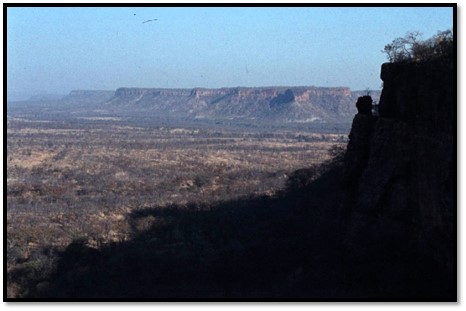
Photo Justin Seymour-Smith: Zambesi Valley Escarpment (Chabatabhere) on headwaters of Kausiga river, looking west towards Nenyunka
Shave spirits
These are said to be the spirits of dead animals such as lions, baboon, vulture and hyena. A special beer ceremony is held at which these spirits come out. Those people who represent the shave spirits will become possessed and behave like the animal that possesses them.
Diviners
There are many types of diviners who use various methods such as Hakata, Kampendo (mini mat) axe, bottle, etc. Generally diviners are not mediums, but some mediums can divine also.
Dunzvi
A dunzvi is described by Hayes as the official in charge of a ritual, often a nephew. A tribal dunzvi is the person sent to Nevana for advice about rain and is usually from a family that married one of the founding ancestor’s daughters. All of her descendants may be dunzvi of the chief. A personal dunzvi is usually the son of a man’s sister and it will be his duty to attend to all the funeral rites and ceremonies of his uncle.
Planting ceremonies
The chief said it was the custom for the people to send a little mapfunde (millet) to him before planting. He would mix this with other mapfunde and then brew some beer and make an offering (teura) to the mudzimu and then give permission for the planting to begin. This is done to secure good crops. If the people did not send mapfunde the chief would not take any action, but it is possible the crops might be poor.
First Fruit rites
The chief confirmed these are practised. The people send mapfunde and beer is brewed to thank the mudzimu.
Ownership of the soil and tribute to chiefs
The whole tribe are the owners of the soil, especially those that are dead. Any stranger must get permission before cultivating the soil and only the chief can assign lands and settle land disputes, but if the dispute is in a remote place, he would send a muchinda to settle the matter.
In earlier times chiefs received tribute and as he travelled around the country the people gave him a portion of their produce because it was the chief’s land they were tilling. However this practice stopped around fifty years ago (about 1912)
Election of chiefs
Chief Sileya said he was the Paramount Chief of the Sebungwe District. Some of the chiefs on the Zambesi river are elected without reference to him, but Nemangwe, Nebiri, Negande and Nenyunga all fall under him and he must be consulted in their election as chiefs.
Native Courts
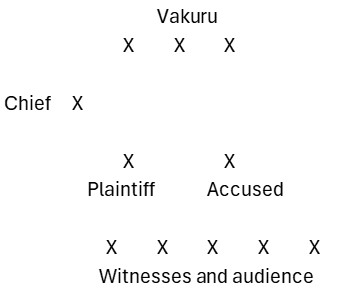
In an important legal case a vakuru is always called to assist the chief, sometimes two or even three of them. They may be relatives of the chief, but they are always men who have proved through past experience that they are good at court work. They are men who can examine, pick out the essentials and who will come to the correct conclusions. They must also be living fairly close to the chief so they can easily attend the court.
The usual procedure is that the plaintiff comes to the chief offering him a badza and pays a magaramutanda (small gift to the vakuru) The chief then sends a munyai to call in the accused. The plaintiff will give the munyai a fowl as his fee and later recover this from the accused if he/she wins their case. In court the plaintiff will state their case first and be cross-examined by the vakuru, who then explain the case to the chief. Then the accused is called upon to answer the charge. During the trial each party can call witnesses on their behalf who will be questioned by the vakuru, who will then pass their recommendations to the chief, who then pronounces his judgement.
The vakuru will receive food and accommodation from the chief as well as the magaramutanda. If (say) the plaintiff is awarded five cattle against the accused, he will give the chief one of the cattle as a hearing fee, but this is left to the discretion of the winner of the case. If the chief is in a distant part of the Sebungwe district he can hold a court as long as there are vakuru available; otherwise he would send the parties to his kraal.

Photo Justin Seymour-Smith: traditional fish trap in Sengwa river
Headman Goredema
Originally VaRozvi, their Mutupo is Moyo.
Headman Madziwadezvido
Same as the Goredema
Headman Makore
Their area had its eastern boundary as the Sanyati river, the southern boundary as the Musongwe river, the Chinyenyetu Hills formed the western boundary on this watershed and then down the Nyaurungu river back to the Sanyati.
This area was occupied by the Makore under Chief Mupare, a traditional enemy of Chief Sileya, and was later called the Copper Queen area. Chief Mupare was a full chief in his own right and did not fall under the paramountcy of Chief Sileya: the Makore originally came from Guruuswa.[12] Legend has it that Chief Mupare refused to report to the Native Commissioner at Old Gokwe to receive his ‘chikingwani’ or chief’s badge as he did not want his people to be conscripted for forced labour (chibaro) from which many of his people had fled.

Imperial War Museum: Chief’s badge in polished brass bearing the armorial crest of Southern Rhodesia in silver,
suspended by a brass chain
Thus Chief Mupare’s chieftainship was not recognised by the Southern Rhodesian Government and in 1912 as part of tsetse-fly control measures the whole of the Makore clan, including Chief Mupare,[13] were evicted from the area. Some people left to live under Chief Chisina, others left the district and settled at Urungwe, Chinhoyi and Sipolilo. As the years went by some people drifted back to their old areas that were still vacant and were accepted and registered under Headman Makore as he was recognised by the administration in that area. Those who drifted back, including Chief Mupare’s son and family, were listed under Makore.
Chief Sileya never sets foot in the Makore area once under Chief Mupare
The first sadunhu[14] was appointed by Chief Sileya about 1912 with the general idea of taking over Chief Mupare’s former area as he had now left. However, Chief Sileya will not enter the area.
In the early days Chief Sileya was set on conquering all this area and the district under Chief Mupare was particularly attractive because of its elephant herds and the potential for gaining ivory (nyanga dzapasi – ivory from dead elephants) Chief Sileya sent his soldiers to defeat the forces of Chief Mupare and the latter, hearing of the army’s approach, consulted his mudzimu, but did nothing more. As they came onto the border of Mupare territory, Sileya’s leading soldiers came upon a pot of cooked sorghum millet. This could not be resisted, so they said “mashura madyiwa” and ate up the contents and all died. Those following also could not resist the food ready to eat and all subsequently died.
As the last of Chief Sileya’s soldiers looked eagerly at the pot and prepared to eat, the Mupare mudzimu spoke to him from the pot and ordered him to return to his chief and inform him of the fate of his army. So much alarmed at this news, the last remaining soldier turned and fled, but only after the mudzimu had cut off one of his ears.
The sole survivor reported back to Chief Sileya, but his story was not believed and a second army was sent to conquer Chief Mupare’s district. Again, there was just one survivor who reported back. A third army were all devoured by a huge snake, leaving just one survivor.
Chief Sileya was now convinced that what the survivors had been telling him was true and sent a final army by a different route up the Sanyati river in an attempt to surprise his foes from the rear, but this time the mudzimu appeared as a lion and devoured all the soldiers, sparing just one to tell the tale.
Chief Sileya now understood he had been outwitted and there was little hope of defeating his erstwhile opponent. However the lure of the ivory was still overwhelming, so he sent off a final army by night with their mission to steal ivory and they used a route that came in from the north. This was successful and they carried off great quantities of ivory, but as they reached the border between the two territories and crossed the summit of the Chinyenyetu Hills, the ivory crumbled into pieces and they were left holding worthless ivory splinters (nyanga dzkanyenduka) which gave rise to the name of the hills.
On hearing of this latest setback, Chief Sileya consulted the mudzimu mukuru, Nyamuswa, who lived in the Nemakonde (Lomagundi) district and was wisely told to give up his attempts to defeat Chief Mupare. Nyamuswa also said that the chiefs must not meet face to face and that Chief Sileya should not enter his opponents territory.
It was said that many years later Chief Sileya was driven by a white man through Makore territory to a store where he was given a blanket. But as he left the store, a whirlwind blew many of the corrugated iron sheets off the store’s roof.
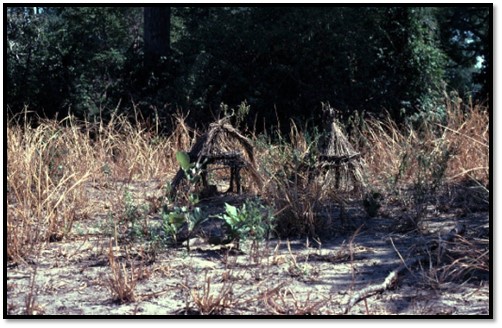
Photo Justin Seymour-Smith: huts (male & female) for the spirit ancestors, each clan has a site for these rituals
Headman Mashani
Their tribe was Mugova, their Mutupo is Tembe
Headman Nambudzia
Their tribe was Shangwe from Zezuru, their Mutupo is Gonde. They moved from Guruuswa at the same time as the Shangwe under Chief Sileya
Chief Nemangwe
His tribe was VaRozvi, his Mutupo is Mpofu (formerly Moyo) Chief Nemangwe lived at Bari and was conquered by Chief Sileya. Both chiefs originally came to the Sebungwe district from Guruuswa and as hunters were attracted by the vast expanses of uninhabited country and abundance of game. They returned with their followers and when they beat on their magic drum it sounded for Chief Nemangwe in the area occupied by him, but not for Chief Sileya, who moved on further north.
Chief Mfungo had granted permission for them to hunt and settle, but they decided he must be overpowered. The legend is that a beautiful girl sat by a waterhole and was presented to the chief and that night alone with him she beheaded him with a sharp knife which she had concealed on her. The Mfungo people were grief-stricken at the loss of their chief and became confused and disorganised and were easily overpowered.
Chief Nemangwe and the fate of Mfungu, the last Bashankwe Chief
D.M. Coley collected oral history from Mtilanwenda, later Chief Nemangwe[15] and Mtena, the Chief being VaRozvi and Mtena being from the Bashankwe. They said about the time that the Abezungu[16] (Portuguese) stopped bartering firearms for ivory[17] and the Bashankwe had been driven from the Zambesi Valley by the BaTonga that Changamire, a powerful VaRozvi Chief, living near a mountain called Gunubugwa somewhere in the north-east, heard of the salt-pans in the Sebungwe and the quantities of ivory in the district.
He chose Sileya (Shona Chireya) then a brave young captain in his army as leader along with Sileya’s younger brothers Njelele and Nemangwe and his half-brothers Sai and Nkoka. It was a dangerous mission; the Sebungwe area was thickly forested with prides of lions and the Bashankwe were formidable opponents with their bows and arrows.
Before he left Sileya asked his ancestral spirits for guidance and as soon as they set off a drum was heard beating in the van of the army. In the dawn and at sunset the drum could be seen, but in daylight it could only be heard. Rumours of the magical power of this drum soon spread and as soon as it was heard the Bashankwe turned and fled. None of the medicines of the spirit mediums could stop its progress. The army’s progress was rapid and the Bashankwe under Mfungu were driven out of the Sebungwe to an area between the Kana and Sanyati rivers where they assembled in a stronghold on Mfungu mountain.
The drum would go no further than the salt pans in the vicinity of Mfungu mountain. So Chief Sileya built a platform where the drum stayed until the first whites came into the district when it disappeared forever.
Twice Chief Sileya’s army attacked Mfungu’s forces in their stronghold but each time Mfungu unleashed his bees that disrupted the attackers and then the defenders shot many of them down with their poisoned arrows.
When Chief Sileya’s sister, Nyangombe, heard of her brother’s defeats she hatched a plan that her brother reluctantly agreed to. She presented herself at Mfungu’s stronghold with her handmaiden and told the guards she had been sent by her brother as a peace offering. Nyangombe was a beautiful woman and liking the idea of an alliance between the Bashankwe and VaRozvi tribes, Mfungu agreed. That night as Mfungu slept, she drew out a hidden dagger and stabbed him through the heart before cutting off his head and escaping from the stronghold back to Chief Sileya.
The Bashankwe became totally disorganised at losing their chief and were defeated in battle. Chief Sileya then settled down near the salt pans and took over the territories once ruled by the Bashankwe.
The Mbikanyama community
Their tribe was VaRozvi, their Mutupo is Dube
They claim to be descendants of Chief Sileya, that they originate from Mboghwe over the Sanyati river, but prior to that they were from Guruuswa.
Mfungo community
They claim their tribe was VaRozvi, their Mutupo is Namungu.
Others say they are originally Basuto (present-day Lesotho) and fled due to tribal warfare and came north and settled in the Sebungwe area because it was nearly uninhabited and wildlife was plentiful and they lived here peacefully until Chiefs Sileya and Nemangwe arrived. Their leader, Chief Mfungo was an expert bee-handler and they were used to keep their enemies away until he was tricked with the chief’s beautiful sister as told above.
The Mfungo had lived peaceably with Chiefs Sileya and Nemangwe until this time. It is claimed that Chief Mfungo was senior to Chief Nemangwe and is still revered locally in spiritual matters and as a rain-maker.
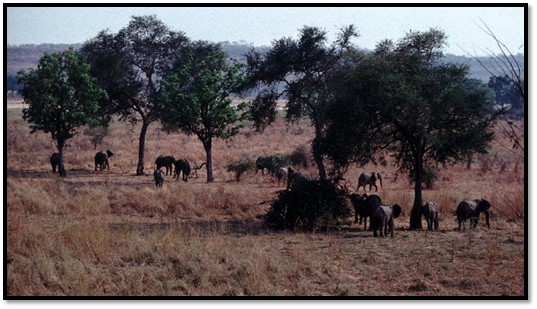
Photo Justin Seymour-Smith: Elephants in the Bumi valley in north Chireya
The Ndhlalambi community
Their tribe was VaRozvi, their Mutupo is Moyo
These people originated from Mpiri Mashawa, beyond Nyamandhlovu. Chief Nemangwe allowed them to settle in the area.
The Nebuwu community
Their tribe was VaRozvi, their Mutupo is Shava
Nebuwu was a son of Chief Sileya, they consult Nevana every year for rain
The Nemasaikada community
Their tribe was VaRozvi, their Mutupo is Shava
Nemasakada was a son of Chief Sileya and brother to Chief Nemangwe
The Wunu community
Their tribe was VaRozvi, their Mutupo is Shava
Wunu married one of Nemangwe’s daughters and became a trusted Mukuwasha obtaining a dunhu from Nemangwe, they consult Nevana every year for rain
Chief Mkoka (Nkoka)
His tribe is BaTonga, originally VaRozvi, his Mutupo is Munyai
The Msala community
Their tribe is BaTonga, originally VaRozvi, their Mutupo is Munyai
The Sianyenzu community
They claim VaRozvi origins, but speak Tonga, their Mutupo is Fyoni (Shiri)
They came from Guruuswa overcame the BaTonga and absorbed them through intermarriage.
Chief Nenyunka
His tribe is BaTonga, originally VaRozvi, his Mutupo is Mpofu (Shava)
Chief Sileya appointed the new Chief Nenyunka, the first was a son of Sileya. When the Vashangwe first came to the area it was occupied by Baleya people and the Vashangwe hunters married the Baleya women and many Baleya’s fearing the amaNdebele fled across the Zambezi, whilst the VaShangwe remained under Sileya’s protection.
The Siamabeuhu community
Their tribe is Balengi / BaTonga, their Mutupo is Dube
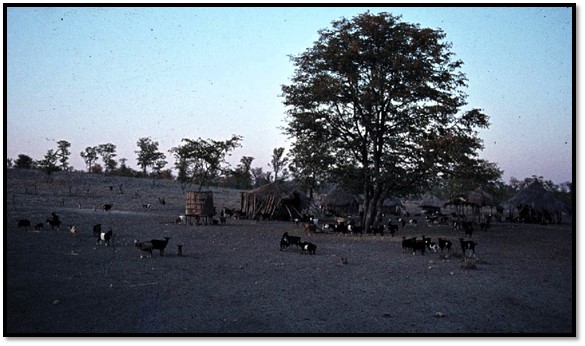
Photo Justin Seymour-Smith: Traditional BaTonga village
Chief (unrecognised) Chirima
His tribe is Shawasha, his Mutupo is Shoko
The tribe originally came from Murewa / Goromonzi area and at one time move to the Rhodesdale area of Kwe Kwe from where the administration moved them to Chief Mkoka’s district. Chirima is a headman under Chief Mkoka and not recognised as a chief.
Chief Jefana
His tribe is Ndebele, his Isibongo is female and his Isiteno is Ntaba Endlangamandhla
A brother of Lobengula and the induna of the Isindeni regiment under Mzilikazi. The tribe moved from the De Beers ranch at Shangani to settle in Gokwe and were given land by Chief Nemangwe.
The Njelele community
Their tribe was VaRozvi, their Mutupo is Mpofu
They claim to have come from Guruuswa at the same time as Chiefs Sileya and Nemangwe, but Chief Sileya claims they followed later. The tribe first settled on the Mdzongwe river where their ancestral graves are situated at Kadzongwana and where the remains of their store huts can be found. The BaTonga people hold their rain and spiritual ceremonies at this traditional burial ground. Kore, an old man living at Tongwe and in some way connected with the earlier Matunzwi claims that the present chief may not approach these graves because he was not installed spiritually, neither can he take part in any rain ceremonies in Tongwe.
The Njelele people found Gumbero and his people living in this district and settled around the little Chidoma and they claimed the territory northwards as far as the Nyarupakwe river. This caused tension between the groups that at times gave rise to conflict.
Mutoyerwini had an elder brother who was lame but considered to be a powerful medicine man well-known for his potions in time of war. His name was Njelele and he matched his skills against a rival from the Gumbero tribe. The contest took place not far from Njelele Business Centre in a vlei called Novanhu. Njelele successfully proved his superiority, so the area was divided between the two factions with the boundary at Novanhu meaning ‘dividing.’ Mitoro (rain making ceremonies) are held each year at Novanhu.
The Gumbero community under Headman Chisina
Their tribe was Vahera, their Mutupo is Shava or Mofu
The Gumbero were originally part of the Vahera under Nyashanu at Buhera. They moved to this district a long time ago and their first ancestors were buried near Chidoma and they had a spiritual pool on a small stream west of Chidoma Hill. The Gumbero have always been closely associated with the Mvurumo people and arrived in the district at the same time. Damatsika, a Mvurumo ancestor was a son of Gumbero’s sister and both families are believed to have settled in the district long before Njelele and his group.
Chief Gumbero quarrelled with the early administration over the chibaro system and it is claimed that for this reason they recognised Njelele as chief and not Gumbero. Chisina ruled his people under Njelele without any official recognition until 1957 when he was given headman status.
Both Headman Chisina and Mvurumo assist each other in rain-making.
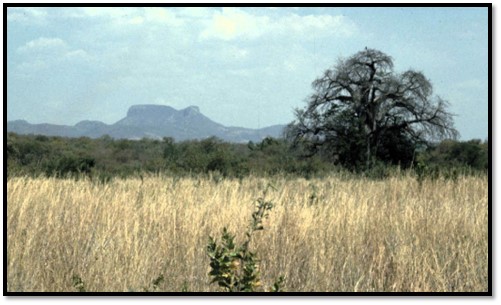
Photo Justin Seymour-Smith: Tundazi (Mt Cromwell) in north Chizarira – high points in the region
Headman Mvurumo
Their tribe was Zezuru, their Mutupo is Dube
They claim to have migrated from Mutare to south of the Mwembezi which was later promulgated as crown land and they were moved to the present area. They claim to have always close ties with Headman Chisina.
Headman Chigiji
Their tribe was Zezuru, their Mutupo is Dube
After leaving the Shangani river they settled at the Mdzongwe head waters under Chief Njelele. The group later moved to Sikombela and from there moved to Ngondoma head waters. They had to leave this area which was required for white farms. They then settled on the Mbumbuzi that was proclaimed a forest reserve in 1962 and the government ordered them to move away. As they were moving under orders of the government they neglected to pay the usual respects to Chief Nemangwe and this caused problems.
Mande community
Their tribe was Vashangwe (they speak Sindebele) their Mutupo is Chuma
Wadigwa, a tribal ancestor was a Mlisa under Chief Malisa who fell under the Kwe Kwe administration, but when the district boundaries were made, he fell under Chief Njelele of Gokwe and was the first Mlisa to be recognised by Njelele. Mitoro are held every year.
Chief Simuchembu
Their tribe was BaTonga, their Mutupo is Mukowa / Sibanda
Succession is on matrilinear lines. The Simuchembu people once lived on the Mafungabusi Plateau and owned livestock. However due to repeated amaNdebele raids they fled to the Zambezi Valley. They claim no relationship with the Gwembe BaTonga, who they refer to as Majokojoko. The BaTonga who lived on the opposite Zambesi bank are related to them and have been moved to areas adjacent to the Gwembe BaTonga.
Simuchembu’s people were moved from the Zambesi Valley in 1956 and told to settle themselves on the Sabara and Sengwa rivers. Some settled on the western bank of the Sengwa river and when the boundaries were fixed in 1957 found themselves in the Binga district.
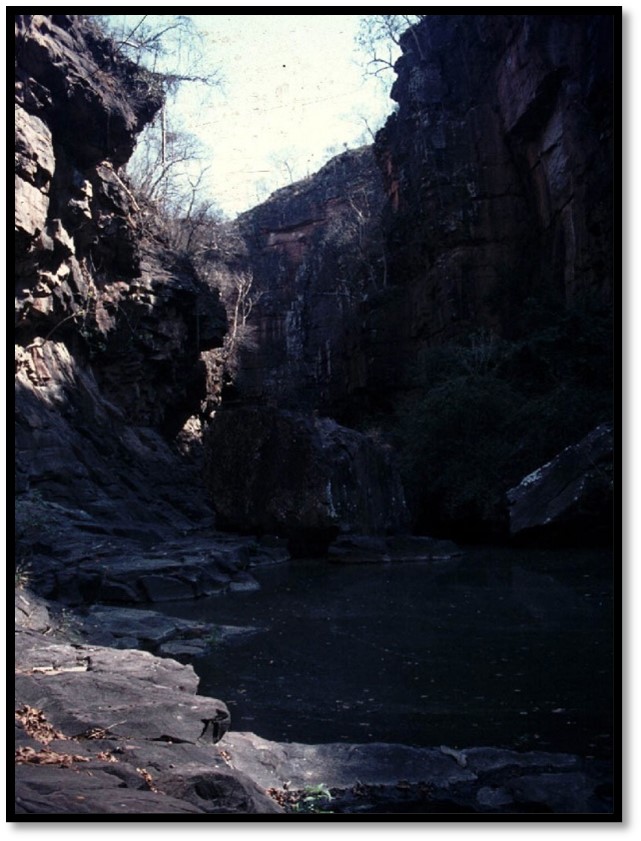
Photo Justin Seymour-Smith: Reyobwe Gorge – east Chizarira flowing into Sengwa
Chief Sayi
Their tribe is VaRozvi, their Mutupo is Neube-Chidau, Sawunyunyu and Gwarumangombe
Chiefs Sayi, Mfungo and Nyamsasa are related and were the first to occupy the district and were later conquered by Chief Sileya’s people. The Sayi are not certain of their origins. Sayi was a name given to Sawunyunyu, but they do not know the meaning of the original name and it has now become a mudzimu name.
Headman Mlisa-Ngomeni
Their tribe is Kalanga (from Plumtree area) their Mutupo is Sibanda-Chidau, Shumba
Ngomeni moved into the area as a traveller and married Chief Siya’s daughter. As a brother-in-law he has gained an important position and as a mukuwasha he shares with Simutenga the responsibility of choosing Chief Sayi’s successor.
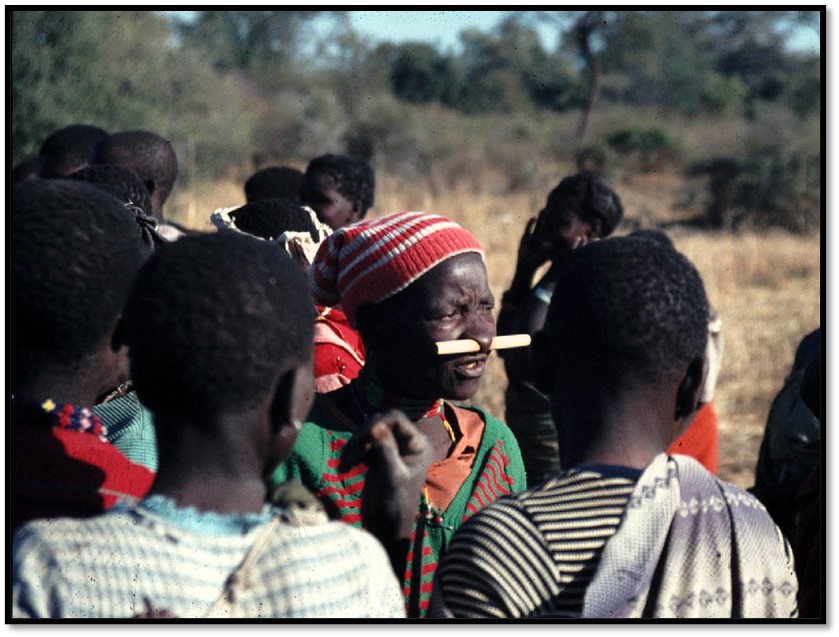
Photo Justin Seymour-Smith: BaTonga group
References
D.M. Coley. The fate of the last Bashankwe Chief. NADA 1927, P65-66
M.E. Haye. Chief Chireya’s Community – Gokwe. Nov 1974
H.N. Hemans. The Log of a Native Commissioner. Books of Rhodesia, Gold Series Vol No 15, Bulawayo, 1971
F. Marr. Some Notes on Chief Sileya. NADA 1962, P81
D.K. Parkinson. The Vashangwe of Chief Chireya. NADA 1968, P20
(all given to me by Justin Seymour-Smith)
Notes
[1] Ethnography (from the Greek éthnos "folk, people, nation" and gráphō "I write")
[2] A Native Commissioner’s life in the Sebungwe District prior to World War I under Matabeleland North province on the website www.zimfieldguide.com
[3] Mutupo is the animal that has been chosen by a community for its special qualities and believed to be sacred to their clan
[4] Hayes states their Mutupo / Chidau is Shava / Nyahuni; Nyahuni being Chief Chimera’s father and was changed to Shava because ‘we have gained a livelihood in the country with blood’ (Taka shava nyika ne maropa)
[5] Chief Sileya is said to have travelled with a drum called Chivundika that rolled itself along unaided and had strange powers. It drummed without assistance, could climb trees and swim rivers. The drum was like a living thing; if stabbed blood poured from the wound. Some of Chimera’s followers followed a swarm of locusts (msashu) and eventually settled at Hwange. Their chief was known as Bashu after the locusts they followed, the name later changed to Pashu. Sileya’s people travelled to the east of the Ume river to one of its tributaries called the Nyamafuro. The area was known to them as in former times they travelled here to obtain Nyoka tobacco grown by Chief Nemangwe’s people.
[6] The above notes are mostly from D.K. Parkinson’s article written in 1968
[7] Clearly the notes state different origin areas
[8] The Native Commissioner Herbert Hemans spent his initial six years posting at Old Gokwe (1911-1916) and his second posting (1923-25) at the new camp at present-day Gokwe and as he does not mention Chief Sileya’s appointment as chief it must have been made in his absence (1917-1922)
[9] Kamba must be the local name of the Native Commissioner at the time
[10] Dzimbabwe (dzimba “houses” mabwe, plural of ibwe “stone”)
[11] Ngozi is equivalent of a Shona mudzimu
[12] Guruuswa, literally ‘the place of long grass’ is both a physical place in the lands of Dande, but also occupies a spiritual concept as a symbol of fertility and motherhood. In their mythology the Korekore people tell how the mhondoro Mutota travelled from Guruuswa to find natural salt described to him by Nyakatonje, who came from Mbire, as his people had previously obtained salt by burning cattle dung. In his mission to find the salt, he took his sons Chingoo, Nebedza and Zvimba and his daughters Nehanda Nyamita Nyakasikana and Peduru. The journey was extremely lengthy and difficult and required great moral strength and commitment. Zvimba gave up the journey apparently near present-day Chinhoyi. At one point in the journey Mutota, who lacked a large army, sought to make peace with Nyamazunzu, by offering his daughter Peduru to Nyamazunzu’s son. The marriage celebrations lasted two nights and the warrior “mukwasha’’ [son-in-law] fell asleep from drinking beer. Peduru slit his throat and beat a drum to message her father. Then Mutota and Chingoo entered the village and killed all the Nyamazunzu family and claimed control of Guruve country.
[13] Chief Mupare moved to the Chisiba area, where he died, still unrecognised by the administration
[14] The Sadunhu is part of tribal structure and has administrative responsibility for the area of the dunhu. This area, with clearly defined boundaries, usually has a number of villages and it is controlled by a sadunhu who traditionally was appointed by his Chief but is often passed on through hereditary succession. For this purpose, the tribal spirits not only have to be consulted but also have to approve the person who is next in line of succession. Often the sadunhu has a special presence within the community owing to this relationship with the tribal spirits. He is responsible for allocating the arable and pastoral lands to the villagers; but his greatest responsibility is in trying the more serious cases and he answers to the chief for the welfare of his area and good conduct of his people.
His position has considerable power and responsibility for his people and they look to him for the various matters which affect their lives. He will always consult his people on matters that affect them and together with his counsellors, he will seek the consensus of opinion of his people.
[15] The Fate of the last Bashankwe Chief
[16] Wazungu / mzungu in Swahili Literally means "foreigner" but is mostly used to refer to refer to white people
[17] Sometime between 1684 and 1693 the Rozvi successfully pushed out the Portuguese, ending their direct control over the interior trade routes and establishing themselves as the dominant political force on the Northern Plateau of present-day Zimbabwe. See the article Dambarare – an Afro-Portuguese Feira site under Mashonaland Central on the website www.zimfieldguide.com
When to visit:
n/a
Fee:
n/a
Category:
Province:
